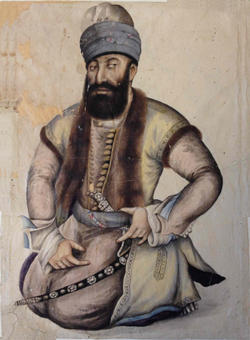| Karim Khan Zand کریم خان زند | |
|---|---|
| Vakil ol-Ra'aya (Deputy of the People) | |
 Contemporary portrait of Karim Khan Zand. | |
| Vakil ol-Ra'aya of Iran | |
| Reign | 1751 – 1 March 1779 |
| Predecessor | Nader Shah (as Shah of Iran) |
| Successor | Mohammad Ali Khan Zand |
| Born | c. 1705 Pari, Safavid Iran |
| Died | 1 March 1779 Shiraz, Zand Iran |
| Burial | |
| Consorts | Khadijeh Begum Shakh-e Nabat |
| Issue | Mohammad Rahim Abol-Fath Khan Zand Mohammad Ali Khan Zand Anwar Shirazi Saleh Khan |
| Dynasty | Zand dynasty |
| Father | Inaq Khan Zand |
| Mother | Bay Agha |
| Religion | Twelver Shia Islam |
Mohammad Karim Khan Zand (Persian: محمدکریم خان زند, romanized: Mohammad Karīm Khân-e Zand; c. 1705 – 1779) was the founder of the Zand dynasty, ruling from 1751 to 1779. He ruled all of Iran (Persia) except for Khorasan.[1] He also ruled over some of the Caucasian lands and occupied Basra for some years.
While Karim was ruler, Iran recovered from the devastation of 40 years of war, providing the war-ravaged country with a renewed sense of tranquillity, security, peace, and prosperity. The years from 1765 to Karim Khan's death in 1779, marked the zenith of Zand rule.[2] During his reign, relations with Britain were restored, and the East India Company allowed to have a trading post in southern Iran. He made Shiraz his capital and ordered the construction of several architectural projects there.
Following Karim Khan's death, civil war broke out once more, and none of his descendants was able to rule the country as effectively as he had. The last of these descendants, Lotf Ali Khan, was executed by Qajar ruler Agha Mohammad Khan Qajar, who became the sole ruler of Iran.
- ^ Perry 2011, pp. 561–564.
- ^ Fisher et al. 1991, p. 96.